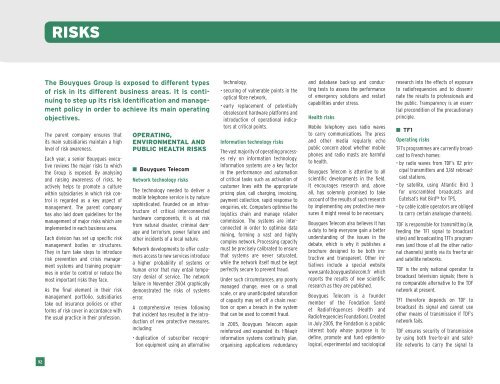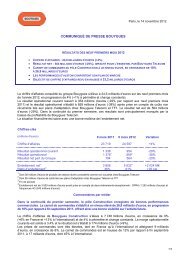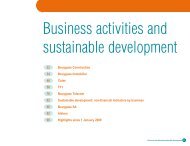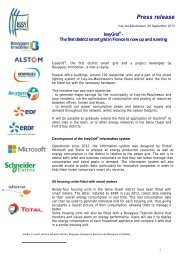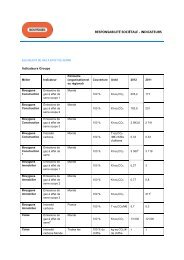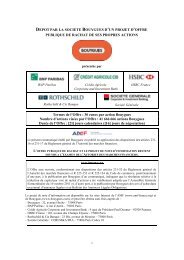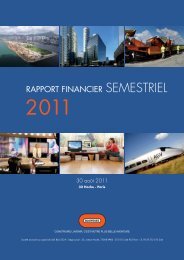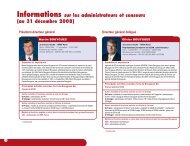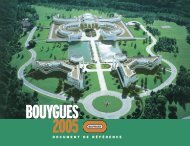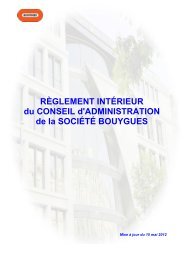A N N U A L R E P O R T - Bouygues
A N N U A L R E P O R T - Bouygues
A N N U A L R E P O R T - Bouygues
You also want an ePaper? Increase the reach of your titles
YUMPU automatically turns print PDFs into web optimized ePapers that Google loves.
RISKS<br />
The <strong>Bouygues</strong> Group is exposed to different types<br />
of risk in its different business areas. It is continuing<br />
to step up its risk identification and management<br />
policy in order to achieve its main operating<br />
objectives.<br />
The parent company ensures that<br />
its main subsidiaries maintain a high<br />
level of risk awareness.<br />
Each year, a senior <strong>Bouygues</strong> executive<br />
reviews the major risks to which<br />
the Group is exposed. By analysing<br />
and raising awareness of risks, he<br />
actively helps to promote a culture<br />
within subsidiaries in which risk control<br />
is regarded as a key aspect of<br />
management. The parent company<br />
has also laid down guidelines for the<br />
management of major risks which are<br />
implemented in each business area.<br />
Each division has set up specific risk<br />
management bodies or structures.<br />
They in turn take steps to introduce<br />
risk prevention and crisis management<br />
systems and training programmes<br />
in order to control or reduce the<br />
most important risks they face.<br />
As the final element in their risk<br />
management portfolio, subsidiaries<br />
take out insurance policies or other<br />
forms of risk cover in accordance with<br />
the usual practice in their profession.<br />
OPERATING,<br />
ENVIRONMENTAL AND<br />
PUBLIC HEALTH RISKS<br />
■ <strong>Bouygues</strong> Telecom<br />
Network technology risks<br />
The technology needed to deliver a<br />
mobile telephone service is by nature<br />
sophisticated. Founded on an infrastructure<br />
of critical interconnected<br />
hardware components, it is at risk<br />
from natural disaster, criminal damage<br />
and terrorism, power failure and<br />
other incidents of a local nature.<br />
Network developments to offer customers<br />
access to new services introduce<br />
a higher probability of systems or<br />
human error that may entail temporary<br />
denial of service. The network<br />
failure in November 2004 graphically<br />
demonstrated the risks of systems<br />
error.<br />
A comprehensive review following<br />
that incident has resulted in the introduction<br />
of new protective measures,<br />
including:<br />
• duplication of subscriber recognition<br />
equipment using an alternative<br />
technology,<br />
• securing of vulnerable points in the<br />
optical fibre network,<br />
• early replacement of potentially<br />
obsolescent hardware platforms and<br />
introduction of operational indicators<br />
at critical points.<br />
Information technology risks<br />
The vast majority of operating processes<br />
rely on information technology.<br />
Information systems are a key factor<br />
in the performance and automation<br />
of critical tasks such as activation of<br />
customer lines with the appropriate<br />
pricing plan, call charging, invoicing,<br />
payment collection, rapid response to<br />
enquiries, etc. Computers optimise the<br />
logistics chain and manage retailer<br />
commission. The systems are interconnected<br />
in order to optimise data<br />
mining, forming a vast and highly<br />
complex network. Processing capacity<br />
must be precisely calibrated to ensure<br />
that systems are never saturated,<br />
while the network itself must be kept<br />
perfectly secure to prevent fraud.<br />
Under such circumstances, any poorly<br />
managed change, even on a small<br />
scale, or any unanticipated saturation<br />
of capacity may set off a chain reaction<br />
or open a breach in the system<br />
that can be used to commit fraud.<br />
In 2005, <strong>Bouygues</strong> Telecom again<br />
reinforced and expanded its I-Réagir<br />
information systems continuity plan,<br />
organising applications redundancy<br />
and database back-up and conducting<br />
tests to assess the performance<br />
of emergency solutions and restart<br />
capabilities under stress.<br />
Health risks<br />
Mobile telephony uses radio waves<br />
to carry communications. The press<br />
and other media regularly echo<br />
public concern about whether mobile<br />
phones and radio masts are harmful<br />
to health.<br />
<strong>Bouygues</strong> Telecom is attentive to all<br />
scientific developments in the field.<br />
It encourages research and, above<br />
all, has solemnly promised to take<br />
account of the results of such research<br />
by implementing any protective measures<br />
it might reveal to be necessary.<br />
<strong>Bouygues</strong> Telecom also believes it has<br />
a duty to help everyone gain a better<br />
understanding of the issues in the<br />
debate, which is why it publishes a<br />
brochure designed to be both instructive<br />
and transparent. Other initiatives<br />
include a special website<br />
www.sante.bouyguestelecom.fr which<br />
reports the results of new scientific<br />
research as they are published.<br />
<strong>Bouygues</strong> Telecom is a founder<br />
member of the Fondation Santé<br />
et Radiofréquences (Health and<br />
Radiofrequencies Foundation). Created<br />
in July 2005, the Fondation is a public<br />
interest body whose purpose is to<br />
define, promote and fund epidemiological,<br />
experimental and sociological<br />
research into the effects of exposure<br />
to radiofrequencies and to disseminate<br />
the results to professionals and<br />
the public. Transparency is an essential<br />
precondition of the precautionary<br />
principle.<br />
■ TF1<br />
Operating risks<br />
TF1’s programmes are currently broadcast<br />
to French homes:<br />
• by radio waves from TDF’s 112 principal<br />
transmitters and 3,161 rebroadcast<br />
stations,<br />
• by satellite, using Atlantic Bird 3<br />
for unscrambled broadcasts and<br />
Eutelsat’s Hot Bird for TPS,<br />
• by cable (cable operators are obliged<br />
to carry certain analogue channels).<br />
TDF is responsible for transmitting (ie,<br />
feeding the TF1 signal to broadcast<br />
sites) and broadcasting TF1’s programmes<br />
(and those of all the other national<br />
channels) jointly via its free-to-air<br />
and satellite networks.<br />
TDF is the only national operator to<br />
broadcast television signals; there is<br />
no comparable alternative to the TDF<br />
network at present.<br />
TF1 therefore depends on TDF to<br />
broadcast its signal and cannot use<br />
other means of transmission if TDF’s<br />
network fails.<br />
TDF ensures security of transmission<br />
by using both free-to-air and satellite<br />
networks to carry the signal to<br />
92


